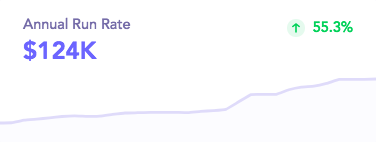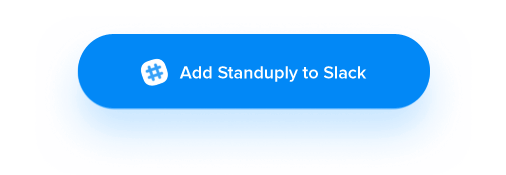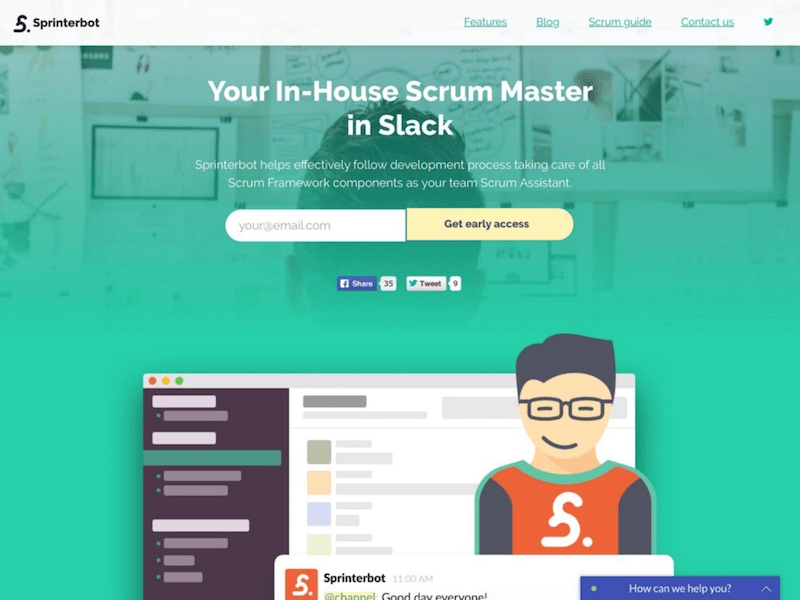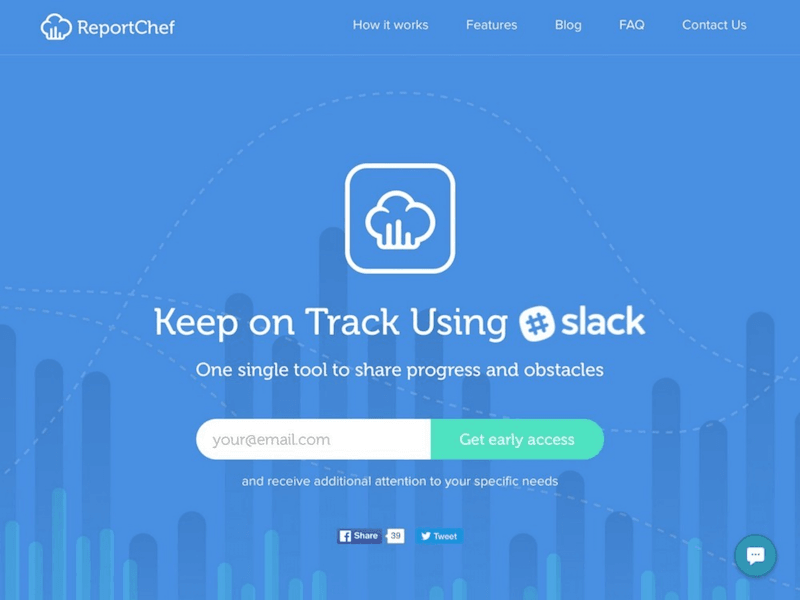We turned a business idea to $100k product (see me launching it above).
Here are our learnings covered in this case study:
— how we picked the right business idea;
— why starting with one developer is counterproductive;
— how important is it to talk to your target audience and ignore the rest;
— successful bot criteria;
— bonus: a product launch checklist;
. . .
Update: read our latest story how we built and grew our Slack bot from zero to profitability: Slack Bot Business Tutorial: From Zero to $25,000/mo.
. . .
In April 2018, Standuply broke $100k in annual run rate. We reached 500 customers and $19k in revenue working from Siberia and without funding. That’s challenging ⛄

Before we got to that state we experimented for nine months in 2016; changed the concept three times and at some point, we were almost ready to give up.
Eventually, we found the right track. A beta product we built led us to hundreds of customers and $75k in sales so far.
This post is about the first year in the works, which was full of uncertainty, mistakes, and learnings. What a CRAZY year it was!
How we picked the business idea
Artem Borodin, Standuply co-founder, is a Project Management veteran who also teaches Project Management classes. Artem saw how Agile teams have evolved and felt their pains with managing processes.
It was 2016 which brought up the chatbot hype. I was EXCITED about the new opportunities and shared my business ideas with Artem.
Together, we envisioned a Scrum Master bot that could be helpful for Agile teams. As a platform we chose Slack – it was the right choice that made us thrive.

We hired an engineer and with the team of three started our long journey. New platform brought new challenges for our engineer. Thus, our team was moving slower than expected.
Unsurprisingly, it took us a couple of months to build the first MVP. This is how SprinterBot (a bot that helps running Agile sprints faster) met the world.
Lesson learned
[socialpug_tweet tweet=”Have at least two developers to keep going faster. One person can get stuck coding something new.” style=”1″]
If you don’t have a business idea yet, here’s my dedicated post how to come up with the internet business opportunity: Techniques to Find Your Billion Dollar Idea.
Did we follow that advice? Yes, to some extent. These techniques really helped us:
Talk to Professionals
As I mentioned above, Artem is a project management professional who witnessed many challenges in Agile teams. Later we proved that by talking to other managers.
Talk to people who work in the area of your interest or where you see the highest potential. Without any doubt, most of them face lots of challenges in their professional life and know the details that make sense.
Ask questions, listen carefully and write down their answers. Here are questions you may use.
— What tasks are you responsible for doing in your business day to day? (Listen for response)
— Which of those tasks take the most time and which do you like the least?
— Tell me about how you go about doing (insert task from the response above). Stop and listen for 60 seconds.
— If you could wave a magic wand and do anything related to (insert task from the response above), what would it be?
After a dozen of discussions, you may spot some repeating answers. It could be what you are looking for. Ideally, 25–30 talks of this kind are needed to gather enough data to start seeing repetitive patterns.
What Drives You?

I always wanted to work on something meaningful for the likeminded people. That’s why our business idea of a bot for Agile teams INSPIRES me from the day one.
Time flies when we enjoy something. These are the moments that can bring in new opportunities. To find out an inspiration, you can follow this simple plan.
1. List activities which you truly enjoy doing. Select three or five the best ones.
2. Talk to yourself in detail: what do you really like in each of those activities.
3. Find one or two most painful problems about these activities.
4. Describe in details how to solve these problems if you had all the resources.
5. Tell your friends and peers about the solution and get their feedback.
6. Describe in detail the minimal viable solution. How would it look like?
7. Determine what you need to build the prototype and proceed to actual work.
Decide what should be your next second step and schedule it for tomorrow morning (if necessary, wake up earlier).
Looking for Complaints
Every time someone complains, write it down. It could be about customer service or how expensive bath towels are. Listen for phrases such as ‘I hate’, ‘I wish’, ‘thats so annoying’. These are queues for potential startup ideas.
Search on Twitter can also be very insightful. And we did that a lot.
Twitter is often used to post complaints addressed to companies or share thoughts aloud. Here are some more phrases that can take you closer to insights.
“I wish I had”
“is the worst product”
“that’s so frustrating”
“does anyone know how”
You can also read feedback sections on different websites with users ideas and comments. From time to time, you can find something interesting.
. . .
Brought to you by Standuply, the Slack bot that manages standup meetings.
Need a Scrum Master in Slack? Hire Standuply for that.

How we got our early adopters
After publishing an upcoming page (see below) on Betalist.com, 300 people subscribed to our waiting list. Not bad.

We planned to ship within a week but eventually shipped Sprinterbot in 4 weeks. It often happens this way, right? ?
Invitation emails were sent, and we’ve been waiting for our first users. But, we got fewer signups than expected. Not good.
Most of the subscribers left interest due to silence from our side. Still, 50 teams signed up. Half of them tested the bot, and a dozen of teams started using it.
Lesson learned
[socialpug_tweet tweet=”Keep in regular touch with your subscribers before delivering the beta. Warm up their interest.” style=”1″]
Then we decided to look for new users and feedback on Slack communities. We had over 150 talks< in two months. But it didn’t help ¯\_(ツ)_/¯
We defined criteria of a person from our target audience: IT manager of a software development team on Slack. Then Artem and I approached those people via DM with a short and personal message like “Hey Jane, could you do me a favor?”
1/3 would talk to us, and those talks may have lasted up to 30 minutes. People are open and helpful if you ask gently. Here’s a useful article about networking on Slack communities.
Most people were skeptic about our concept and our bot, but we did get few signups and some pieces of advice.
Moreover, we found that both our unknown bot and other popular Slack bots got the same reaction — skepticism, and disapproval.
It turns out we were talking to people who were slightly different from our real target audience.
Later we found users and then customers who had no skepticism, but a strong need for our product. They were IT managers from remote software development teams and were using Slack bots.
A slight difference made a huge change. Incredible!
Lesson learned
[socialpug_tweet tweet=”Know who’s eaxactly your target audience. Talk to them and ignore the rest.” style=”1″]
Pivot, pivot!
To decide what to do next, we summarized all our customer development talks. Yes, including those from people outside our target audience. Oops.
Some people didn’t like the concept of a Scrum Master bot. Half of them didn’t follow Scrum. However, many liked that a bot can ask questions and gather answers, e.g., for standup meetings.
To embrace that, we decided to provide a user ability to change questions allowing a broader set of use-cases.
We redesigned our webpage and changed the product’s name (not a good move). It became ReportChef (like a chef that serves reports based on various recipes).

It was launched on Betalist and social networks. This time we put up a referral system with perks based on Tim Ferris post, but it didn’t work out. Nobody wanted to invite their friends before trying a product.
However, it wasn’t the only pitfall on our way.
After we made our positioning wider, it became unclear to visitors what we were doing. Ouch.
At that time about 50 teams were using ReportChef, and it didn’t feel like a strong demand. We were STUCK.
Inspiration found
I went to Bits & Pretzels conference to talk to people, find inspiration, and drink beer at Octoberfest ?
But ReportChef didn’t catch any attention when I was talking about it. I felt FRUSTRATED and started to think whether I should quit…
With those thoughts in mind, I went to a men’s room. Locked the door, I noticed a written text right in front of my eyes — “Never ever give up”.
THANKS, man! It was an inspiration I needed in a place I barely though could be in any sense inspirational ?
I decided to do my best and get our product going WHATEVER it might take me in the next six months. A bit later things started to shake up.
Getting to the sauna
We certainly needed a detached view. But there are only a few startup teams around in Siberia, and no-one was in SaaS business. If you’re drilling oil, it’s the place to go.
So, we decided to apply for Startup Sauna acceleration program in Helsinki. It doesn’t take equity and provides a wide network of experts — just what we needed.
Our team was lucky to be among 15 teams chosen for the Fall ’16 program. Yeah!

The program was very useful, intensive and fun. What a GREAT time it was! I will share our experience in a dedicated post about Startup Sauna later on.
During the program, we came up with Standuply brand and concept. Then we launched it at Startup Sauna demo day and on Product Hunt at the same time.

In a couple of days, we received over 200 teams on board. A week later we published the bot in Slack App Directory. There Standuply began its steady growth.
Later we decided to automate other Agile processes — retrospective meetings, burn-down charts, etc.
So, the story started with building a Scrum Master bot, pivoted and came back to the original concept. Was that a 3rd pivot? ?
In the next posts, I will share insights about our growth and how we built a successful product based on our initial business idea.
Speaking of growth, check out our latest relevant post:
17 Amazing Authors on Growth We’re Learning From (Bonus: 300 Growth Hacks)
Successful bot criteria
We have a criteria list of a successful bot in our internal wiki. It’s our point of view, so don’t consider it as rock-solid truth.
I’d like to share it hoping it will be useful to you.
1. Replacing a process altogether.
A bot has to replace a process altogether to achieve full adoption across the whole team.
If a user has to keep the old workflow occasionally, it will hurt bot’s adoption. Also, it will raise the question “why should we pay for the bot if we’re still doing things the old way?”
That’s why it’s practical to start with a tiny process and then expand the functionality.
2. Added value
A bot should bring added value to a process compared to the old way of doing things. Sounds trivial, but we saw many examples of making a bot for the sake of a chatbot.
3. Solving the pain
In the best scenario, a bot not only brings added value but solves the real pain. For example, it notifies when an app crashes right where all the team communicates.
This way it quickly becomes part of the workflow.
4. The ease of use
It should be easier to use a bot then solving a task in an old way. Typing too much isn’t cool.
Compare ordering UBER in a couple of clicks via the app with typing your full address to a chatbot.
5. Clear value proposition
People are choosing and using bots because of their value. Thus, the value proposition should be clear and solid.
It could be applied to any product, though.
6. Scalability
Bot’s features should be scalable within the same value proposition. In the perfect example, several joint processes can be automated via a bot.
It can be applied to features or client sizes. I.e., starting with SMBs and then going to Enterprise.
Know more? Please add them in the comments below.
Finding a business idea is not an easy task. Sometimes if you don’t know where to start, it’s better to start with business ideas that are publicly available and don’t seem very unique. It reminds me of a situation where I and my friend wanted to start a business: we had an offer to start managing his parent’s barber shop or come with some unique idea.
We were evaluating dozens of things and eventually didn’t start anything. I’m sure if we would start with a barbershop it could lead us way far despite that barbershop idea doesn’t look so sexy. Making your first step is what matters a lot.
Check out our ultimate guides on How To Use Slack Effectively In 2019 and How to Put Agile Processes on Autopilot.
Photo credits: Slush
Get a Checklist How to Launch a Business Idea
Based on this story we prepared a checklist how to launch your internet business.
Get it to your inbox and start planning your launch today ?
[pum_sub_form provider=”mailchimp” form_layout=”inline” form_alignment=”center” form_style=”default” name_disabled disable_labels label_submit=”Get Checklist” placeholder_email=”Enter your email” closedelay=”1″ openpopup_id=”0″ list_id=”e39da12811″ double_opt_in=”disable”]
. . .
Brought to you by Standuply, the Slack bot that manages standup meetings.
Need a Scrum Master in Slack? Hire Standuply for that.

Do you want to ask for my advice? Here’s my profile at Standuply Mentors, reach out directly to me for any help you may need.


